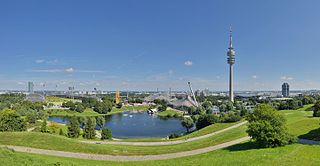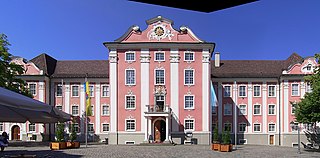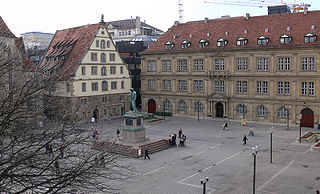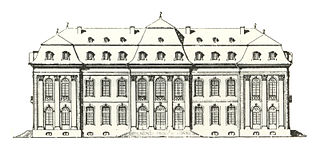
Stuttgart is the capital and largest city of the German state of Baden-Württemberg. It is located on the Neckar river in a fertile valley known as the Stuttgarter Kessel and lies an hour from the Swabian Jura and the Black Forest. Stuttgart has a population of 635,911, making it the sixth largest city in Germany. 2.8 million people live in the city's administrative region and 5.3 million people in its metropolitan area, making it the fourth largest metropolitan area in Germany. The city and metropolitan area are consistently ranked among the top 20 European metropolitan areas by GDP; Mercer listed Stuttgart as 21st on its 2015 list of cities by quality of living; innovation agency 2thinknow ranked the city 24th globally out of 442 cities in its Innovation Cities Index; and the Globalization and World Cities Research Network ranked the city as a Beta-status global city in their 2020 survey. Stuttgart was one of the host cities for the official tournaments of the 1974 and 2006 FIFA World Cups.

Unter den Linden is a boulevard in the central Mitte district of Berlin, the capital of Germany. Running from the City Palace to Brandenburg Gate, it is named after the linden (lime) trees that line the grassed pedestrian mall on the median and the two broad carriageways. The avenue links numerous Berlin sights, landmarks and rivers for sightseeing.

Schloßplatz is a square located on Museum Island (Museumsinsel) in Berlin, Germany. It measures about 225 m by 175 m, with its long side oriented on an axis approximately southwest/northeast. At its west corner is the Schlossbrücke, from which Unter den Linden leads west to the Brandenburg Gate. From the same corner, Karl-Liebknecht-Straße runs northeast alongside the square and on to Alexanderplatz. Until the early 20th century, only the square south of the palace was so named, the square north of it being the Lustgarten.

Egon Eiermann was one of Germany's most prominent architects in the second half of the 20th century. He was also a furniture designer. Since 1947, he was Professor for architecture at the Technical University of Karlsruhe.

The New Palace is an 18th-century Baroque palace in Stuttgart and is one of the last large city palaces built in Southern Germany. The palace is located in the on the Schlossplatz in front of the Jubiläumssäule column and Königsbau. Public tours of the building are only permitted by special arrangement, as the building contains some government offices. Once a historic residence of the Kings of Württemberg, the New Palace derives its name from its commissioning by Duke Carl Eugen of Württemberg to replace the Old Castle in the early years of his reign. Originally, Charles commissioned Nikolaus Friedrich Thouret, but architects Leopoldo Retti, Philippe de La Guêpière, Reinhard Heinrich Ferdinand Fischer would contribute to the design, history, and construction of the palace.

The Olympiapark in Munich, Germany, is an Olympic Park which was constructed for the 1972 Summer Olympics. Located in the Oberwiesenfeld neighborhood of Munich, the Park continues to serve as a venue for cultural, social, and religious events, such as events of worship. It includes a contemporary carillon. The Park is administered by Olympiapark München GmbH, a holding company fully owned by the state capital of Munich.

Leo von Klenze was a German neoclassicist architect, painter and writer. Court architect of Bavarian King Ludwig I, Leo von Klenze was one of the most prominent representatives of Greek revival style.

The Old Palace is a former castle located on the Schillerplatz in Stuttgart, Germany. The castle, originally a water castle dating back to the 10th century, was the residence of the Counts and later some Dukes of Württemberg and today is the home of the Landesmuseum Württemberg. The castle church still functions as a place of worship.

The New Town Hall is a city hall in Hanover, Germany. It opened on 20 June 1913 after construction lasting 12 years. A magnificent, castle-like building of the era of Wilhelm II in eclectic style at the southern edge of the inner city just outside the historic city centre of Hanover, the building is embedded within the 10-hectare (25-acre) Maschpark.

Feuerbach is a borough (Stadtbezirk) of the city of Stuttgart. Its name is derived from the small river of the same name that flows from the neighboring district of Botnang through Feuerbach. Feuerbach is home to one of Germany's biggest industrial giants and is surrounded by the districts of Zuffenhausen, Bad Cannstatt, Stuttgart-North, Stuttgart-West, Botnang and Weilimdorf.

The Neues Schloss Meersburg is located in Meersburg near Lake Constance in Baden-Württemberg, Germany. From its construction in 1750 until the bishopric was dissolved in 1803 it was the seat of the Prince-Bishop of Constance.

Schillerplatz is a square in the old city centre of Stuttgart, Germany named in honour of the German poet, philosopher, historian, and dramatist Friedrich Schiller. Schillerplatz stands to the south west of Stuttgart's main square, Schlossplatz.

Stuttgart Christmas Market, known in German as the Stuttgarter Weihnachtsmarkt is a Christmas market that takes place every year during Advent in the German city of Stuttgart.

The Poststadion is a multi-use stadium in the locality of Moabit of the borough of Mitte in Berlin, Germany. The stadium was built in 1929 for the sports club of the German Reichspost at the site of a former Prussian Uhlan parade ground. It is adjacent to the Fritz Schloß Park.
The following is a timeline of the history of the city of Stuttgart, Germany.

Plieningen is the southernmost borough (Stadtbezirk) of Stuttgart in the state of Baden-Württemberg. Plieningen is located about 10 kilometres (6.2 mi) from the city center of Stuttgart on the Filder Plain. Schloss Hohenheim, part of the Stuttgart Airport, and the parking garage for the Stuttgart Trade Fair are located here.

Gößweinstein Castle, also called Schloss Gößweinstein, is a mediaeval hilltop castle in Gößweinstein in the county of Forchheim in the German state of Bavaria. It towers high above the market town and the River Wiesent and may have been the inspiration for Richard Wagner's grail castle in his opera, Parsifal. The castle is a Bavarian listed building, no. D-4-74-129-10.

Schloss Philippsfreude was a rococo Schloss in Wittlich in Rhineland-Palatinate, Germany. It served as a hunting lodge and summer palace for the Prince-Electors of Trier. It was destroyed by French revolutionary troops in 1797. Today, nothing is left anymore.

Christoph Sattler is a prolific German architect who has been professionally active since the early 1970s. Most of his more prominent buildings are in southern Germany or Berlin. Although he is known for a number of large high-profile residential developments, he has also attracted widespread critical and public attention with public buildings and structures such as the Seeparkturm in Freiburg, the Kupferstichkabinett in Berlin, various underground stations such as those of Am Hart (Munich) and Mendelssohn-Bartholdy-Park (Berlin) and several art galleries including the controversial Gemäldegalerie in Berlin. He studied for several years during the 1960s in North America as a post-graduate student. During that period he was employed with the firm of Ludwig Mies van der Rohe.

Ernst Bernhard Sehring was a German architect.


































